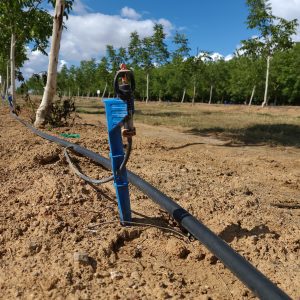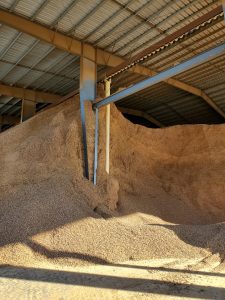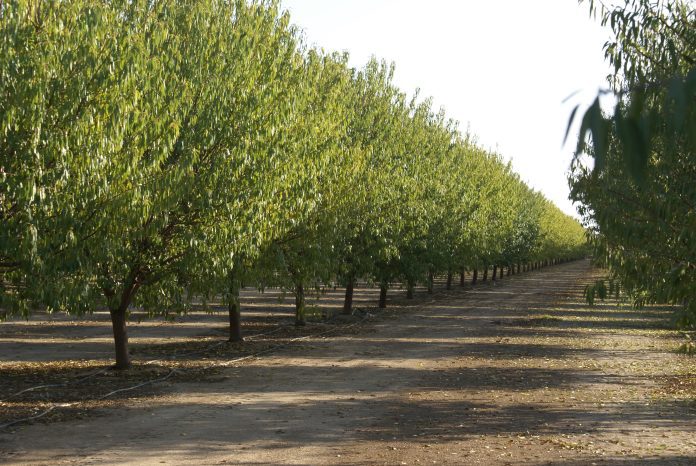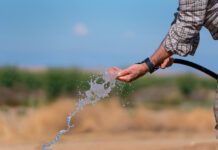Increasing irrigation efficiency has been an ongoing endeavor in the almond industry, but, as drought and water use pressures on growers increase, more attention is being paid to the technologies designed to further improve efficiency.
The 50th Almond Conference brought together panelists from the field and the laboratory to explain how sensing technologies and irrigation evaluations can save water and irrigation costs.
An additional conference panel discussion focused on fertigation, making practical recommendations to address increasing nutrient costs and assist with fertilization plans.
Remote sensing tools will be one avenue for managing water and protecting tree health.
“You want to be able to see early stress,” UC Davis researcher Mallika Nocco said. Thermal cameras can capture that early stress. When leaf stomata close in response to high temperatures, leaf temperatures rise.
“A cooler tree is a happier tree,” she said.
She emphasized optimizing water use rather than deficit irrigation scheduling. In orchard rows, that includes precision monitoring for specific cultivars. At the orchard level, that includes use of precision irrigation, using lysimetry or UAVs for monitoring on a daily or weekly basis.
Optimized irrigation or controlled deficits can be strategies on the orchard level with monitoring by aerial sensing. Moving to the groundwater basin level, managed aquifer recharge, groundwater banking and public-private partnerships can be used.
Nocco cited the T-REX project, Tree Crop Remote Sensing of Evapotranspiration Experiment, to help growers further optimize water use in orchards.
Automation to collect measurements of stem water potential, daily estimates of actual ET at the tree scale using drones or satellite data or methods to monitor stress responses are some of the long-term goals of the project which is funded by the Almond Board and CDFA.
Tools include drones, hyperspectral imagery, eddy covariance systems and field-based observations and measurements of radiometric canopy temperature, stem water potential, photosynthesis and actual ET.
On a much larger scale, managed aquifer recharge capturing flood water, using remote sensing for site suitability and orchard response are also tools to manage irrigation water.
Tom Devol, Almond Board’s senior manager of field outreach and education, noted that simple tests for distribution uniformity in an irrigation system have the potential to save money.
“DU can have a big impact on the bottom line,” Devol said. “Testing is recommended at least once every three years.”
Common causes of non-uniformity in an irrigation system are clogged emitters, system leaks and mixed nozzles. The goal is to operate the system at 95% efficiency. Most pressurized systems are operating at 85% or less, Devol said.
Almond Board partners with Resource Conservation Districts across the state to promote DU testing with mobile irrigation laboratories. Kevin Greer, who operates a mobile lab out of the Red Bluff area, said when you put numbers to system inefficiencies, you can see where money is lost.
A missing sprinkler at 0.87 gpm is 52.2 gallons per hour. That equals 1,253 gallons lost in a 24-hour set and 18,792 gallons a year at 20 sets. Improper line repairs, leaks at filters and clogged screens all add up to lost water and yield losses.

Fertigation When Times are Tight
Rising costs of nutrients will mean almond growers must make do with less, UC researcher Patrick Brown said in a panel discussion at the Almond Conference. Applying nutrients correctly is the number-one way to save costs, he added.
Nitrogen and potassium are the macronutrients most important for production. Zinc and boron lead the list of micronutrients that must be managed. Phosphorus and calcium are macro nutrients that must be monitored and applied when necessary.
Brown recommended optimizing nitrogen and potassium with a nutrient budget approach: Supplying them at the right time and the right amount. That means matching supply with tree demand and considering all inputs, including nitrogen in irrigation water and residual soil nitrogen. Applications also need to be done when roots are active.
“Always start when trees are hungry,” Brown said. Knowing yields will help in determining the amounts of nitrogen.
Research has shown that in mature almond trees, from dormancy to mid leaf-out, there is very little N uptake. Uptake begins at mid leaf-out and is essentially complete by hull split. New numbers from the Almond Board show N demand from first leaf to maturity. At first leaf, the total non-yield N demand directed to leaves and woody biomass is 30 lbs. By third leaf, total non-yield N demand is at 65 pounds plus the expected yield times 0.068.
Brown said that differences between years, orchard zones and cultivars impact N decisions.
Potassium is the most expensive nutrient, but almost identical to N in timing and demand.
In N decision making, Brown said to always have a cultivar-specific, yield-driven fertilization strategy. That requires prediction and in-season adaptation. In-field variability should be identified and corrected by investing in correcting local nutrient deficiencies and fertigation system optimization. He noted that N is not retained well between seasons in low-organic-matter soils, and a uniform field N rate cannot be efficient.
Yield mapping can be a tremendous tool in almond production, Brown said. Yield determines both N and K demand. Brown noted that cultivars and orchard zones differ in productivity and nutrient demand. Unlike N, K is not lost below the root zone, but remains in the system for future use. Reducing K applications in these areas is possible, Brown said. He also warned that measuring and interpreting soil and tissue K is more difficult than any other element.

Almond hulls and shells can serve as nutrient sources, potentially saving in fertilizer costs. Brown said that at current prices, using hulls and shells at 4 tons per acre to return N and K to orchards can save $300 in N and K alone, but there are the added benefits of increased soil health and water retention.
“Increase efficiency, don’t cut nutrients,” panelist Tommy Bottoms said. Bottoms, who is with Timothy and Viguie Farming and El Molino Farms, noted that fertigation will always be worse in terms of efficiency than irrigation.
He advised taking a close look at the actual irrigation system and determining its level of performance, sampling water to determine nutrient output and correcting problems.
Bottoms also stressed the value of developing a nutrition management team. A significant portion of the production budget is in the hands of those responsible for feeding the trees. They should look at other orchards, both good and bad, and develop a sense of ownership. After irrigation schedules and fertilizer amounts, the check list includes determining fertilizer run times, starting the pump and checking for leaks and pressures.
“Calculate, measure and check again. Monitor tank levels,” Bottoms said. To achieve continuous improvement, understand crop demand and move toward continuous fertigation by using high-frequency, low-volume applications, improving estimation of tree yield and recognizing opportunity cost. Bottoms said that if automation is part of the solution, it must be made cheaper and easier to implement.












